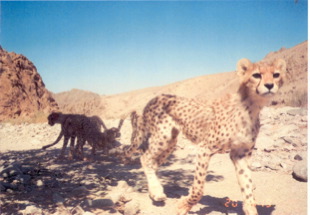
A family of five Asiatic cheetahs (four cubs and their mother) photographed by a remote camera trap in Iran's Dar-e Anjir Wildlife Refuge. The New York-based Wildlife Conservation Society and Iran's Department of Environment are collaborating on a conservation project in this region to safegurd the remaining population of these extremely rare cats. I.R.Iran DOE/CACP/WCS/ UNDP-GEFWildlife Conservation Society (WCS) scientists, working in conjunction with Iran’s Department of Environment (DOE) in an isolated region in the Dar-e Anjir Wildlife Refuge, recently discovered that a remote camera set out to survey wildlife had photographed an entire family of extremely rare Asiatic cheetahs. The pictures show an adult female and her four youngsters resting in the shade of a tree, marking the largest-known group of these rare cats ever photographed in Asia.
Once ranging from the Red Sea to India, the Asiatic cheetah today is hanging on by only the thinnest of threads. Fewer than 60 exist on the entire Asian continent, mostly on Iran’s arid central plateau, where WCS and Iranian biologists have been conducting surveys of this highly endangered big cat since 2001.
“As a species the cheetah is still in dire straits in Iran, so it is extremely encouraging to see an apparently healthy family in their native habitat,” said Dr. Peter Zahler, assistant director for WCS’s Asia Programs. “Images like these give hope to conservationists that there is still time to save these magnificent animals.”
Initiated by a major grant and ongoing support from the United Nations Development Program’s Global Environment Facility, WCS began its collaboration with Iranian scientists by surveying five protected areas where cheetahs were still thought to exist. The group found a variety of suitable habitat, but also discovered that prey species, such as jebeer gazelle and urial sheep, were scarce. The latest photographs hint at the gradual recovery of prey populations.
“Cheetahs in Iran live on a knife-edge in very marginal habitat,” said Dr Luke Hunter, coordinator of WCS’s Global Carnivore Program. “The fact that this female has managed to raise four cubs to six months of age is extremely encouraging. Hopefully, this indicates there are areas where the cheetah’s prey species are coming back, a goal the Iranian DOE and UNDP has been working very hard to achieve.”
In the 1970s, estimates of the number of cheetahs in Iran ranged from 100 to 400 animals. But widespread poaching of cheetahs and their prey during the early years of the 1978 revolution, along with degradation of habitat due to livestock grazing, have pushed this important predator to the brink of extinction. Once known as “hunting leopards,” cheetahs have played a significant historical role in Iranian culture being trained by its emperors to hunt gazelles in ancient times.
Asiatic cheetahs went extinct throughout much of the Middle East about 100 years ago, though they occurred in Saudi Arabia until the 1950s. They vanished in India in 1947; spotty records claim they ranged in Central Asia as far as Kazakhstan from the 1960s through 1980s.
Source: Wildlife Conservation Society
 Print Article
Print Article Mail to a Friend
Mail to a Friend
